- Administrator
- Albums and Singles
 The first new full-length in five years from these drifters could not have been christened any more appropriately. Over three quarters of an hour Windy and Carl build dreams. Isolating all the emptiness and distance sometimes found in the mind and soul, they soothe everything away in a blur of tones that would make the local cathedral sound positively heavenly.
The first new full-length in five years from these drifters could not have been christened any more appropriately. Over three quarters of an hour Windy and Carl build dreams. Isolating all the emptiness and distance sometimes found in the mind and soul, they soothe everything away in a blur of tones that would make the local cathedral sound positively heavenly.As soon as "The Eternal Struggle" begins it is clear that that the duo is addressing the demons that get a chance to express themselves in the middle of the night, at the most frightening moments of human exposure and vulnerability. But, instead of being a dark album, every moment of this album is akin to being elevated out of a nightmare and into the warm and welcoming hands of the daytime. The wavering hum that begins the album is the last moment of fear and the first moment of some understanding, the feeling of calm and relaxation that hits as soon as the adrenaline pumps itself out and allows the muscles to relax.
All the force and energy associated with pain is redirected, breathing slows, ideas slowly begin to form, and the self is recaptured, allowed some room to move about instead of being controlled by elementary fear and alertness. More and more tones pile on top of still more tones until an impossible slide of sound has been solidified.
For just a brief moment it's obvious what Windy and Carl up to, but before it can be grasped, they move on, emphasizing the idea of infinite, incomplete, and satisfying composition. The only sure thing on this record is change. At times a heavily subdued and relegated bass line seems to pump away in the background, like the pulse of the heart or the tick of a clock, but it's only there momentarily, completely submerged beneath the hovering choir that permeates the entire album, like the light of the moon shifting on water. It's haunting, at times its removes me from the room and traps me, the very essence of the dark surrounding my head.
There is a depressing lean to the music, but the beauty it exudes stands above whatever desolation comes with the passing of dreams.
The second disc is another chance for everyone to hear Dedications to Flea, an EP released on Brainwashed and dedicated to the duo's dog, Flea. The liner notes detail the life and death of this pup and, as corny as this may be, is actually a bit heart-wrenching. I guess it all depends on how much of an animal lover one is. The use of sound from their walks with Flea only adds to the weight of the album and it is a fine compliment (as different as it is from The Dream House) to an already excellent album. Some drone groups seem to carry with them an emptiness that no amount of arrangement could fix, but The Dream House seems full, brimming over with a misty breath that is fulfilling, brilliant, and sometimes sad.
Listening to the album from start to finish is a wonderful experience, sounding more human and adventurous than any other album this year.
samples:
Read More
- Administrator
- Albums and Singles
 There's something about the music of Thighpaulsandra that is quintessentially British sounding, but this compositional four-track spurt from the Welsh Valleys doesn't rely on stirringly pompous anthems or traditional folk instrumentation to do it.
There's something about the music of Thighpaulsandra that is quintessentially British sounding, but this compositional four-track spurt from the Welsh Valleys doesn't rely on stirringly pompous anthems or traditional folk instrumentation to do it.
There’s an audible grandness of sound to Chamber Music that evokes some kind of depraved royalty, and when combined with the sinister darker side to this amiable bright collaborator of the stars, there lies the unique futurepast hybrid of Thighpaulsandra’s sound.
Stepping away from the improv of Rape Scene (but keeping the theme of two-faced album titles) hasn’t altered his musical world all that much and there are strong similarities to that release here despite the songs here having been written and rehearsed; his own description of the album as ‘four men in a room playing’ defies its odd nature. There are many things I’d expect three men to get up to in a room with Thighpaulsandra, and this LP isn’t one of them.
The four intrepid players begin at the edge of Quatermass’s pit for the seven-minute mental health ride of “Cast in Dead Homes.” It’s a typical Thighpaulsandra composition in that you never know what’s the around the next audio corner as he explores imaginary landscapes with a reliable palette of après-prog instrumentation. Like an unravelling Hammer Horror theme there’s always an element of restraint in the song’s theatrical lurching xylophone and ribcage played melody that extends across the whole LP.
The spectre of Tangerine Dream lurks on both “A Blizzard of Altars” and “Bleeding Text for the Cripplethrush,” whose analogue based sounds are slowly filtered through personalized hybrid processors and begin to betray their origins turning up as warped digital conundrums. The erratic swarm of ingredients continues on and ends up including a brief Eastern European/Edgar Allen Poe-style soliloquy alongside a theremin and the sound of fox hunt horns. It even has the temerity to unashamedly end with a section of conservative organ/rock guitar soloing in the finest spirit of prog.
Further highlighting his ability to handle a tune and his empathy with space music “The Unwilling Wardens of Ice” takes the long route of fourteen and a half minutes to lay down some eerie and indistinct curved notes. As expected he ends the song and the album in relative crashing chaos despite taking several almost symphonic whale song-style turns. Judging by his recent release schedule I’ll bet on him confounding expectations again on another release before the year is out.
samples
Read More
- Administrator
- Albums and Singles
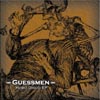 There’s smoke in the air and beer by the laptops as Guessmencombine heavy stamping of the feet, cheap digital damage overload andmuch growling.
There’s smoke in the air and beer by the laptops as Guessmencombine heavy stamping of the feet, cheap digital damage overload andmuch growling.
GM Produce
Atjust under eleven and a half minutes long this four-track releasecovers an area of musical no man’s land with both abandon andreflection in equal amounts. Where Guessmen’s musical soundclashinstantly aurally succeeds while others flounder through musicalpatchworks is the fact that the messy bang and stutter sounds soanimated and exciting.
There’s realskill and attention to detail in making the constantly scatteringparticles of “Average Fish”s glitchy stomping analogueness sound likethe anthem of the most coherent drunk man to ever threaten a yard ofale. With more than enough remarkable debris in the background tothoroughly mangle a less solid tune there’s a coherent electronicjunkyard aesthetic to much of the band’s repertoire that’s occasionallysoftened by more conventional but refreshing instrumentation like theclarinet.
Even though they ablyprove that they bang like the highest heeled unshaven Warp signed glamband ever they’re wise enough to also advertise their more thoughtfulside. The sequencing of the melancholic alcohol tinged regret-filledcloser “Human Being Kind” brings the band a more mature perspectiveleaving the EP with the tinkling of the milkman’s delivery on the‘morning after’. Its softer electronic musical droplets (tears?) andrain on grass FX give a sensible flipside to the megaphone barked freakshow tales and after “Troglodyte”s asthmatic skank has battered thebrain with its tree trunk arms it’s a welcome relief.
samples:
Read More
- Administrator
- Albums and Singles
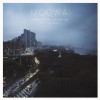
Every time Mogwai release a new album, there is a line of thought that repeats itself among fans yearning for the band's past glories: "Hmm... another reliably average and/or boring Mogwai album... it's no Young Team." Well, I suggest we consider that streak broken—because, 15 years and seven studio albums into their career, Mogwai have recorded and released their very best work...
 
... and buried it on the bonus CD included with the deluxe version of Hardcore Will Never Die, but You Will—another reliably average and/or boring Mogwai album.
First things first: I am blown away each time I listen to "Music for a Forgotten Future (The Singing Mountain)," a long-form composition created to soundtrack an art installation by Douglas Gordon and Olof Nicolai. This restrained, elegant and evocative mini-masterpiece is, frankly, Mogwai's best recorded work. Featuring a three-piece string section (violin, viola, cello) along with piano, gentle chimes, and background tape hiss, "Music for a Forgotten Future" unfolds patiently for 15 minutes, an elegiac music-box lullaby with ominous undertones. Guitars eventually join, building to a brief and well-earned crescendo, followed by a beautiful coda on strings alone. Length aside, this is a much different beast than "Mogwai Fear Satan" or "My Father My King"—trading in muscle for minutiae, "Music for a Forgotten Future" is the work of a veteran band playing to strengths that barely existed in its work until now. This is essential listening—the sample below doesn't begin to do it justice.
Unfortunately, nothing on the proper, patchy album holds a candle to "Music for a Forgotten Future." Mogwai are at their most tedious as a full-on rock band—their tempos drag, sacrificed for the sake of heaviness, and all sense of forward motion in their music disappears. The first song Sub Pop released from Hardcore Will Never Die left me indifferent: "Rano Pano" finds Mogwai straining to capture the sense of churning, psychedelic heaviness perfected by past tourmates Bardo Pond, but coming up empty-handed. The riff at the song's core sounds fine for a few bars, but fails to evolve like Bardo's druggy, kaleidoscopic psych-rock, becoming a chore to endure for five minutes.
To be fair, "Rano Pano" is a contender for the worst song on Hardcore Will Never Die, which is, overall, a notable improvement on Mogwai's dreadful last album, The Hawk Is Howling. One quick-fix addition is the motorik beat that anchors several of these song, allowing the songs to breathe instead of plod. Granted, Mogwai's version of motorik at times sounds studied, unnatural, like it was Xeroxed straight from a Krautrock 101 handbook. Songs like "Mexican Grand Prix," while a breath of fresh air on Hardcore Will Never Die, also make me want to pull out my Neu! and La Düsseldorf records to experience Klaus Dinger's brilliance firsthand—not a tribute to the source material. There are also songs like "San Pedro," which apply the motorik drum pattern in a more forceful, rock-based setting that I find somewhat engaging, but not a strong case for the album overall.
The best song on Hardcore Will Never Die, but You Will doesn't draw from Krautrock, though, and isn't rock-based at all. If anything, I would consider "Letters to the Metro" the baby brother of "Music for a Forgotten Future," a successful translation of that piece's atmospheric beauty into a snapshot one-fifth its length. A simple piano melody anchors "Letters to the Metro," accompanied by strings and an achingly pretty slide guitar in the chorus—subtle, effective embellishment. The enjoyable moments on Hardcore Will Never Die are a reminder that Mogwai's best days are not behind them, but that their key to success is no longer rooted in soft-loud gimmicks and overcooked riffs, but the gorgeous, infinitely compelling ambience of "Music for a Forgotten Future" and its kin.
Samples:
Read More
- John Kealy
- Albums and Singles
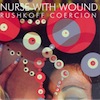 This limited run of rather expensive 7" singles by Steven Stapleton and Andrew Liles are a bit of a mixed bag. It is not Nurse With Wound’s finest hour but it will keep die-hard fans going until the guys get around to another full album. However, for the casual fan this is probably best avoided as the high price and variable quality of the music will most likely leave a sour taste in the mouth.
This limited run of rather expensive 7" singles by Steven Stapleton and Andrew Liles are a bit of a mixed bag. It is not Nurse With Wound’s finest hour but it will keep die-hard fans going until the guys get around to another full album. However, for the casual fan this is probably best avoided as the high price and variable quality of the music will most likely leave a sour taste in the mouth.
 
The sleaze funk of "Sarah’s Beloved Aunt" at first sounds too cheesy and cringe-worthy to enjoy and the porno spoken word vocals also push the boundaries of good taste. However, with repeated exposure it all comes together in the same way as Nurse With Wound's lounge exotica album Huffin' Rag Blues did. The screaming guitars and unpredictable edits and manipulations of the source materials bring this from embarrassing porn pastiche to a celebration of wah guitars and smutty talk.
On the other hand and on the other side, "Bum Brush Effect" feels like a bit of a throwaway inclusion. Layers of meandering noodling on various instruments test my patience and despite trying to get into it, I am just not seeing eye to eye with Stapleton and Liles on this. The best part is unfortunately the brief outro that seems to be the kind of '70s sitcom/elevator music that, although awful, is oddly compelling.
One final note regarding the format, I had balked at the price of Rushkoff Coercion but buckled and went for the picture disc version despite my misgivings about its sound quality. Surprisingly, the usual extra surface noise associated with picture discs is completely absent and while I cannot say that the full cost to my wallet was justified, I can at least see that the overall production quality is high. The poster sleeve and picture disc match the music well; a collage of used porn, retro abstract graphics and DNA.
 
Read More
- Administrator
- Albums and Singles
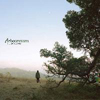 On their fourth full-length record, Arbouretum turn their churning rhythms and buzzing guitars inward to explore the uncanny spaces of the collective unconscious. Inspired in part by Carl Jung, Dave Heumann's lyrics are featured more prominently on The Gathering, which might explain why the band sounds looser and less aggressive this time around. The change accentuates Arbouretum's strengths and shows off Heumann's stupendous songwriting ability.
On their fourth full-length record, Arbouretum turn their churning rhythms and buzzing guitars inward to explore the uncanny spaces of the collective unconscious. Inspired in part by Carl Jung, Dave Heumann's lyrics are featured more prominently on The Gathering, which might explain why the band sounds looser and less aggressive this time around. The change accentuates Arbouretum's strengths and shows off Heumann's stupendous songwriting ability.
When I read that Dave Heumann used Carl Jung and the Red Book as a source of inspiration for The Gathering, I immediately restarted the record and focused on Dave's lyrics. Doing so was an involuntary mental reflex. Listening to the album's opener, "The White Bird," a second time, I paid close attention to all of Heumann's symbols and references: small white birds, geomatter, the gloaming, true natures vs. superficial realities, and esoteric knowledge. Images such as these are woven into the fabric of The Gathering, and they are frequently employed to tell stories about traveling, a theme also present in the artwork. Exploring the latent content in Heumann's words inevitably leads to self-exploration, so that listening to the record is a little like participating in it.
Musically, the band follows Heumann on his psycho-spiritual quest. Their inclusive approach, which blends Crazy Horse with Bardo Pond and Palace Music, is the musical equivalent of Dave's nebulous lyricism. Despite having a sound similar to previous records, a number of new musicians are featured on The Gathering. Guitarist Steve Stroheimer and percussionist Daniel Franz are replaced on this record by J.V. Brian Carey, who takes up the skins, and Matthew Pierce, who plays keyboards and serves as a second percussionist; that leaves Dave on the six-string and bassist Corey Allender, who is the only musician other than Heumann who also appeared on 2009's Song of the Pearl.
Oddly, losing one guitarist resulted in a thicker, more layered sound for Arbouretum. Capable of absolutely massive, buzz-drenched squalor, the band also produces eerily atmospheric music, which sometimes supports and sometimes mimics Dave's vocal melodies. No matter how chaotic that confluence becomes, Carey holds the band together, demonstrating once again just how important the drummer is to Arbouretum's music. He and Allender manage to make Heumann and Pierce's efferent noises coalesce, so that The Gathering has a chunky, sometimes pulsing quality about it. Together they open up an inner space, which can be as personal or objective as it needs to be.
But, Dave's symbols and metaphors didn't take on a personal dimension for me until I heard their cover of Jimmy Webb's "Highwayman," which sits at the center of the album. As the Highwaymen, Johnny Cash, Waylon Jennings, Kris Kristofferson, and Willie Nelson made this song popular, but both Glen Campbell and Webb produced outstanding versions of their own. Webb's masterpiece, which is as much about explorers and outlaws as it is about spiritual archetypes, epitomizes the rest of The Gathering perfectly, and also shows that Heumann is as concerned with great songwriting as he is with psychedelic noise and Jungian psychology.
Through the simplicity and directness of that tune, Arbouretum established a firm connection to my own consciousness, primarily because "Highwayman" is one of my favorite songs, but also because it summons up many childhood memories. Afterward, The Gathering took on new dimensions for me, each one adding to my enjoyment. "Highwayman" probably won't have the same effect on other listeners, but I doubt that the band's superb playing and Dave's songwriting would leave anyone unimpressed. The Gathering is a phenomenal record, with or without Carl Jung and his numinous influence.
samples:
 
Read More
 On their fourth full-length record, Arbouretum turn their churning rhythms and buzzing guitars inward to explore the uncanny spaces of the collective unconscious. Inspired in part by Carl Jung, Dave Heumann's lyrics are featured more prominently on The Gathering, which might explain why the band sounds looser and less aggressive this time around. The change accentuates Arbouretum's strengths and shows off Heumann's stupendous songwriting ability.
On their fourth full-length record, Arbouretum turn their churning rhythms and buzzing guitars inward to explore the uncanny spaces of the collective unconscious. Inspired in part by Carl Jung, Dave Heumann's lyrics are featured more prominently on The Gathering, which might explain why the band sounds looser and less aggressive this time around. The change accentuates Arbouretum's strengths and shows off Heumann's stupendous songwriting ability.
- Administrator
- Albums and Singles
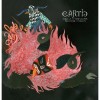 Late last year, Southern Lord released a collection of Earth's earliest recordings, several of which originally appeared on their first EP, 1991's Extra-Capsular Extraction. That may prove a red herring for those wanting the band to revisit its pioneering brand of drone-doom metal. Earth's latest magnum opus continues in the opposite direction, building on the gorgeous gothic Americana debuted on 2005's Hex; or Printing in the Infernal Method. Fortunately, Earth have not only recorded a capable new album—they have made subtle stylistic adjustments that pay off handsomely.
Late last year, Southern Lord released a collection of Earth's earliest recordings, several of which originally appeared on their first EP, 1991's Extra-Capsular Extraction. That may prove a red herring for those wanting the band to revisit its pioneering brand of drone-doom metal. Earth's latest magnum opus continues in the opposite direction, building on the gorgeous gothic Americana debuted on 2005's Hex; or Printing in the Infernal Method. Fortunately, Earth have not only recorded a capable new album—they have made subtle stylistic adjustments that pay off handsomely.
Whether spurred by the unavailability of guitarist Dylan Carlson's prior band mates, his creative restlessness, or a little bit of both, Angels of Darkness, Demons of Light I sees significant changes in Earth's line-up. Steve Moore, who played piano and Hammond organ on 2008's masterful The Bees Made Honey in the Lion's Skull, is absent for this recording. Karl Blau takes the place of Don McGreevy on bass guitar. Most noticeably, Lori Goldston joins the band on cello—an instrument that proves vital to Earth's approach on this album, a heavenly counterpoint to Carlson's endlessly reverberating guitar. As always, Adrienne Davies serves as the band's percussive anchor on "sea hooves and Satans' knuckles" as well as Carlson's songwriting partner.
At its core, Earth has focused on slow tempos, minimalism and repetition for the last 20 years: less is more, Carlson has often said. On Angels of Darkness, the band takes a step back from the complex, jazz-influenced sound of The Bees Made Honey and simplifies its songwriting, drawing attention to the striking, cinematic interplay between Carlson's guitar and Goldston's cello. This album is all about nuance: the way Carlson carefully strikes each chord, letting it resonate patiently in the open space between Davies' steady drum hits, notes bending and quivering against a backdrop of subterranean electric bass. Colorful smears of cello breathe depth into the songs, weaving around and through Carlson's enveloping guitar tones, filling out Earth's lush sound. The five songs play well together as a suite, centering on subtle improvisation within simple, repetitive, long-form structures that I find hypnotic, absorbing and ultimately satisfying.
The final song, "Angels of Darkness, Demons of Light I," was improvised and recorded live in the studio, stretching out to 20 minutes. It takes its time getting off the ground, with cello and bass slowly fading in before Carlson and Davies join. The session unfolds to gorgeous effect, a resonant wash of guitar and cello tones rising and falling throughout; toward the song's end, guitar and drums disappear and the track closes, fittingly, as it began—on cello and bass. Two years ago, songs from The Bees Made Honey were reborn on 2009's Radio Earth EP, a live recording that set aside the immaculate production of Bees and let the band interact in a spontaneous setting. That Angels of Darkness, Demons of Light I closes with a similar, beautifully paced recording—itself the capstone on an album full of songs that showcase Earth's live chemistry—is a major success.
Samples:
Read More
- Administrator
- Albums and Singles
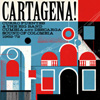 The late Curro Fuentes was quite a fascinating guy.  The youngest brother of the Fuentes musical dynasty that dominated Colombian music for four decades, he stayed behind on the coast and started his own studio when Discos Fuentes relocated to the city of Medellin (he found highland food to be "insipid"anyway).  Combining some of Colombia's biggest jazzmen with the most exciting young musicians culled from Cartegena's many red-light district casinos, brothels, and strip clubs, he produced a slew of scorching, sexed-up big band records in the '60s.  Cartagena! assembles many of them, but the high level of quality here makes me think that the vault is far from empty.  I sincerely hope there will be a sequel.
The late Curro Fuentes was quite a fascinating guy.  The youngest brother of the Fuentes musical dynasty that dominated Colombian music for four decades, he stayed behind on the coast and started his own studio when Discos Fuentes relocated to the city of Medellin (he found highland food to be "insipid"anyway).  Combining some of Colombia's biggest jazzmen with the most exciting young musicians culled from Cartegena's many red-light district casinos, brothels, and strip clubs, he produced a slew of scorching, sexed-up big band records in the '60s.  Cartagena! assembles many of them, but the high level of quality here makes me think that the vault is far from empty.  I sincerely hope there will be a sequel.
Cartagena! is a sequel of sorts to 2007's Columbia!, which covered the output of Discos Fuentes (the label run by Curro's brothers Antonio and Rafael) around roughly the same period.  Despite Discos Fuentes' huge success, Curro always chose to remain separate, starting off with with his own Discos Curros imprint before eventually teaming up with Phillips.  In a way, Curro's studio was kind of a Colombian analog to Factory Records, as it was very devoted to Cartagena's local music scene and there was a lot of overlap between bands–many musicians that led their own bands happily lended their talents to other ensembles.  Consequently, Curro's productions drew from a pretty unparalleled talent pool.  Equally important is the fact that Fuentes had very strong opinions about what sounded good and wasn't at all shy about sharing them, replacing percussionists and pianists himself if they couldn't get a track just right.  Also, he was one of the first cumbia producers to make heavy use of electric bass, which he liked quite loud.
The eclectic array of performers that Fuentes drew together resulted in some interesting cross-pollinations between Latin music genres, which goes a long way towards explaining why this music is so spectacular.  The young musicians from Cartagena's clubs made damn sure that the rhythms were raucous and propulsive, while their more established counterparts ensured that the arrangements were skillful and inventive.  Despite the disparate backgrounds and the high level of musicianship, everyone could agree upon the very populist objective of heating up dancefloors.  As such, this music was very focused on appealingly accessible elements like wild percussion, sultry grooves, and memorable hooks, which is quite different than where American jazz was headed around the same time.
Of all the artists, I was most impressed by saxophonist/bandleader Lucho Bermudez, who is the sole returnee from Colombia! (Soundway sure loves exclamation points).  Bermudez's two pieces are the most perfect synthesis of all of the great stuff happening on this album: fluid solos, driving (but not hyperactive) grooves, virtuosic percussion, infectious enthusiasm, quirkiness, character, and lots of vocal whoops and yelps (which are very important to me).  He is not the sole stand-out by any means, though, as I was similarly taken with the songs by several other bands–particularly that of Lucho's chief rival, Alex Acosta.
Primary compiler Roberto Guymant contributes some alternately informative and amusingly hyperbole-filled liner notes, the latter of which I found extremely charming ("The first time I heard this track, my brain immediately melted out my ears and dribbled down my shirt.").  Even though I don't quite agree that Crescensio Camacho's trumpets are apocalyptic or that Los Seven Del Swing embody what Black Sabbath would have sounded like if they'd been raised on the Colombia coast, his enthusiasm is pretty contagious.  Also, he clearly knows what he is talking about both musically and historically, which is not easy when there are so many regional scenes and similar-sounding genres (to my non-Colombian ears) combining and mutating.  To give an example, I learned that the upper classes were scandalized when jazz and cumbia were first combined in the 1940s because it made young Colombians "dance like blacks."  Fortunately, the young people had a lot more influence on where their culture was headed than the wealthy, reactionary types.  Of course, as much as I love colorful anecdotes and uncomfortable cultural factoids, the most important thing of all is quality of the music and Roberto and his co-curators simply have great taste.  A few pieces are certainly too frenzied or locked-groove-sounding for my taste, but they are largely outnumbered by excellent ones.  This is a thoroughly fun and vibrant album.
Samples:
- Lucho Bermudez Y Su Orquesta Sabanera, "Arroz Con Coco"
- Orlando Fortich Y Su Orquesta, "Yolanda"
- Alex Acosta Y Su Orquesta, "La Gozadera"
 
Read More
- Administrator
- Albums and Singles
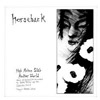
Pairing one of Matthew Bower's newer projects with Jenks Miller’s minimalist metal band is a wise move for Turgid Animal, and this 10" delivers the expected amount of guitar-focused chaos from both artists.
Voltigeurs' side-long track "Dew Blest Adawning" seems to have more in common with Total than Skullflower, instantly launching into full bore noise and not relenting until the needle hits dead wax.Throughout the echoed din, it sounds like there's actual guitar and synth sounds there somewhere, but destroyed beyond all recognition.It's almost like there's a melody to be heard, but it's so fully immersed in distortion that it's only a fleeting glimpse.
Horseback does two tracks, and both are rather different but nicely show the old school drone by way of riff heavy metal sound Miller has been cultivating."High Ashen Slab" opens with rapid, live drums and a repetitive organ melody that are (of course) propelled by overdriven guitar riffs.The guttural metal vocals which I'm normally not fond of work well, placed in the mix more like another instrument than traditional singing.Carefully the guitars take over, becoming noisier and more prominent before ending in a hollow land of guitar noise and screamed vocals.
"Another World" goes to more traditional drone metal territory, mixing a processed melodic loop and a thin, pounding beat.It’s much more about texture, with less focus on big, heavy riffs or subtle melodies.Eventually the latter pops up towards the end, shining through the gray roar triumphantly.
Between the two, I’ve got to give the edge to Horseback, who has been consistently impressing me since hearing The Invisible Mountain (before it was on Relapse).With the almost '70s hard rock tinged "High Ashen Slab" and the disciplined textural noise of "Another World," Miller's strengths are clear.The Voltigeurs side is more than competent, but has less of an original sound in comparison, not separating itself drastically from other guitar noise bands.
samples:
 
Read More
- Administrator
- Albums and Singles
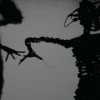
Since the Afghan Whigs called it quits a decade ago, frontman Greg Dulli has been quietly releasing a stream of solid, occasionally fantastic albums with his current band, the Twilight Singers. Dulli's latest release is his first with the Singers since recording the Gutter Twins' debut with former Screaming Trees vocalist and frequent collaborator Mark Lanegan.
The moment I saw the cover art for Dynamite Steps, which echoes the grayscale, shadowy palette of 2003's Blackberry Belle (secretly Dulli's best album), my interest was piqued. Dulli has been making consistent music for 20 years, first with the Afghan Whigs' brand of cathartic 1990s alt-rock shot through with soul, now with the Twilight Singers' downtempo, back-alley blues. An enjoyable album from Dulli was a safe bet—I hoped for something more.
As can be expected, Dynamite Steps is not a reinvention or departure. It is Dulli-by-numbers, a master of his craft writing for his audience and sticking a little too close to his comfort zone. The highlights come early: propulsive, piano-driven opener "Last Night in Town" is one of the album's catchiest songs. Mark Lanegan contributes a somber vocal to "Be Invited," adding an effective dose of gravitas: it plays like a great, lost B-side from the Gutter Twins' slept-on Saturnalia. "Waves" is the album's most raucous moment, Dulli's strained vocals atop a bed of dissonant guitars and frantic drumming recalling "I'm Her Slave"-era Whigs. Dulli puts on a powerful live show, and songs like these are his bread and butter on stage—all palpable tension and release, rock and roll melodrama packed with sing-along choruses.
My favorite song, "On the Corner," shares its title with Miles Davis' 1972 jazz-funk masterstroke, likely not by coincidence—Dulli has referenced Davis before on the Whigs' "Miles Iz Ded" (and its remix "Rebirth of the Cool"), written immediately after his passing. "On the Corner" recalls its namesake's groove and pairs it with a couplet that stands out, halfway into an album overflowing with Dulli's trademark seedy lyrics: "All rise with me / all take your place." In between references to Gomorrah, desire, licked lips, spread legs, and dirty kisses, Dulli seems to hint at a desire for spiritual redemption. This theme, touched on at various points, is eventually put to rest on the album's closing track, "Dynamite Steps," which finds Dulli drawn back to earthly desires: "Some speak of a light / control of the game / but I leave the past alone... Push your faith aside... Your medicine is faith / and your flesh divine."
Ultimately, Dulli's work lives or dies by the strength of his songwriting, which is why Dynamite Steps doesn't rank with his best efforts. Consistency is an issue by the album's second half: the songs are mid-tempo, languid and not terribly engaging. Dulli sounds passionate at times, but I find my attention lost because the songs are monochromatic in pace and construction. A potential highlight turned sour, Ani DiFranco's vocal on "Blackbird and the Fox" is pleasant but unmemorable, and it's not for her lack of trying—"Blackbird" falters because it aches for, quite frankly, a hook of any sort. With key exceptions (see the Afghan Whigs' unbelievable "Faded"), slow-burning ballads are not Dulli's strength, so it's disappointing to hear Dynamite Steps resort to them after playing its best cards early.
Despite its flaws, Dynamite Steps is worth a listen with the caveat that, while strong in parts, it is not Greg Dulli's most consistent record with the Twilight Singers. I look forward to hearing its better songs fleshed out on stage as the Singers tour this year, but I may not revisit the album too frequently in the meantime.
Samples:
Read More


